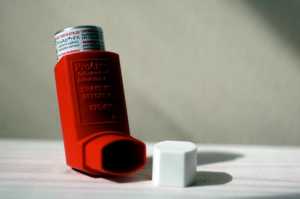
22 Nov Asthma: Biologic Benralizumab (FASENRA) Reduced Need For Rescue Medication
MedicalResearch.com Interview with:
 Sean O’Quinn MPH
Sean O’Quinn MPH
Director, Patient Reported Outcomes
AstraZeneca
MedicalResearch.com: What is the background for this study? How does benralizumab differ from traditional medications for asthma?
Response: FASENRA™ (benralizumab 30mg for subcutaneous injection as add-on maintenance therapy in severe eosinophilic asthma for patients 12 years and older) has a strong clinical profile, including powerful efficacy against exacerbations and the ability to improve lung function. Benralizumab is a respiratory biologic that binds directly to the IL-5α receptor on eosinophils and attracts natural killer cells to induce rapid and near-complete depletion of eosinophils via apoptosis. (NOTE: The mechanism of action of FASENRA in asthma has not been definitively established.) Benralizumab is not indicated for treatment of other eosinophilic conditions or for relief of acute bronchospasm or status asthmaticus. The most common adverse reactions include headache and pharyngitis.
Dependence on rescue medications is indicative of poor asthma control. In the Phase III SIROCCO/CALIMA trials, patients with severe eosinophilic asthma had significantly reduced exacerbation frequency and improved lung function when treated with benralizumab 30mg Q8W (first three doses Q4W) vs. placebo.
Less was known about the effects of benralizumab on rescue medication usage—specifically daily total rescue medication use, daytime and nighttime rescue medication use, and nighttime awakenings requiring rescue medication use. The aim of this analysis was to understand the potential treatment effects of benralizumab on these parameters.
MedicalResearch.com: What are the main findings?
Response: In an analysis of pooled data from SIROCCO and CALIMA, for patients with severe asthma with blood eosinophil counts ≥300 cells/μL, benralizumab Q8W impacted daily and night-time rescue medication use and night-time awakenings requiring rescue medication use by day 3 compared to placebo. Reductions in daytime rescue medication use were obtained by Day 7. At end of treatment (EOT), reductions in rescue medication use and the percentage of nights with awakenings requiring rescue medication use were observed in patients who received benralizumab Q8W.
- Daily rescue medication use at Day 3: -0.39 puffs/day vs placebo
- Daily rescue medication use at EOT: -0.71 puffs/day vs placebo
- Night-time rescue medication use at Day 3: -0.24 puffs/day vs placebo
- Daytime rescue medication use at Day 7: -0.22 puffs/day vs placebo
- Percentage of nights with awakenings requiring rescue medication use at EOT: -4% vs placebo
The analyses of these endpoints were not multiplicity protected. Results are descriptive only.
MedicalResearch.com: What should readers take away from your report?
Response: Dependence on rescue medications is a particularly important concern for severe, uncontrolled, asthma patients. Reducing the need or overuse of rescue medication is an important treatment goal when managing severe asthma.
MedicalResearch.com: What recommendations do you have for future research as a result of this work?
Response: Biologic therapies are important in the treatment paradigm for severe asthma. Continued research on how biologic therapies for severe asthma impact patient-centered and patient-reported outcomes is warranted.
Disclosures. The study was funded by AstraZeneca and the authors are employed by AstraZeneca. Please see Important Safety Information and Prescribing Information for benralizumab below.
IMPORTANT SAFETY INFORMATION
CONTRAINDICATIONS
Known hypersensitivity to benralizumab or excipients.
WARNINGS AND PRECAUTIONS
Hypersensitivity Reactions
Hypersensitivity reactions (eg, anaphylaxis, angioedema, urticaria, rash) have occurred after administration of FASENRA. These reactions generally occur within hours of administration, but in some instances have a delayed onset (ie, days). Discontinue in the event of a hypersensitivity reaction.
Acute Asthma Symptoms or Deteriorating Disease
FASENRA should not be used to treat acute asthma symptoms, acute exacerbations, or acute bronchospasm.
Reduction of Corticosteroid Dosage
Do not discontinue systemic or inhaled corticosteroids abruptly upon initiation of therapy with FASENRA. Reductions in corticosteroid dose, if appropriate, should be gradual and performed under the direct supervision of a physician. Reduction in corticosteroid dose may be associated with systemic withdrawal symptoms and/or unmask conditions previously suppressed by systemic corticosteroid therapy.
Parasitic (Helminth) Infection
It is unknown if FASENRA will influence a patient’s response against helminth infections. Treat patients with pre-existing helminth infections before initiating therapy with FASENRA. If patients become infected while receiving FASENRA and do not respond to anti-helminth treatment, discontinue FASENRA until infection resolves.
ADVERSE REACTIONS
The most common adverse reactions (incidence ≥ 5%) include headache and pharyngitis.
Injection site reactions (eg, pain, erythema, pruritus, papule) occurred at a rate of 2.2% in patients treated with FASENRA compared with 1.9% in patients treated with placebo.
USE IN SPECIFIC POPULATIONS
The data on pregnancy exposure from the clinical trials are insufficient to inform on drug-associated risk. Monoclonal antibodies such as benralizumab are transported across the placenta during the third trimester of pregnancy; therefore, potential effects on a fetus are likely to be greater during the third trimester of pregnancy.
INDICATION
FASENRA is indicated for the add-on maintenance treatment of patients with severe asthma aged 12 years and older, and with an eosinophilic phenotype.
- FASENRA is not indicated for treatment of other eosinophilic conditions
- FASENRA is not indicated for the relief of acute bronchospasm or status asthmaticus
Please read full Prescribing Information, including Patient Information.
Citation: ACAAI 2018 abstract:
O’Quinn S, Xu X, Hirsch I. Rescue medication use reduction with benralizumab for patients with severe, uncontrolled eosinophilic asthma. Presented at: the Annual Scientific Meeting of the American College of Allergy, Asthma, and Immunology; November 15-19, 2018; Seattle, WA. Abstract D200.
[wysija_form id=”3″]
[last-modified]
The information on MedicalResearch.com is provided for educational purposes only, and is in no way intended to diagnose, cure, or treat any medical or other condition. Always seek the advice of your physician or other qualified health and ask your doctor any questions you may have regarding a medical condition. In addition to all other limitations and disclaimers in this agreement, service provider and its third party providers disclaim any liability or loss in connection with the content provided on this website.
Last Updated on November 22, 2018 by Marie Benz MD FAAD
